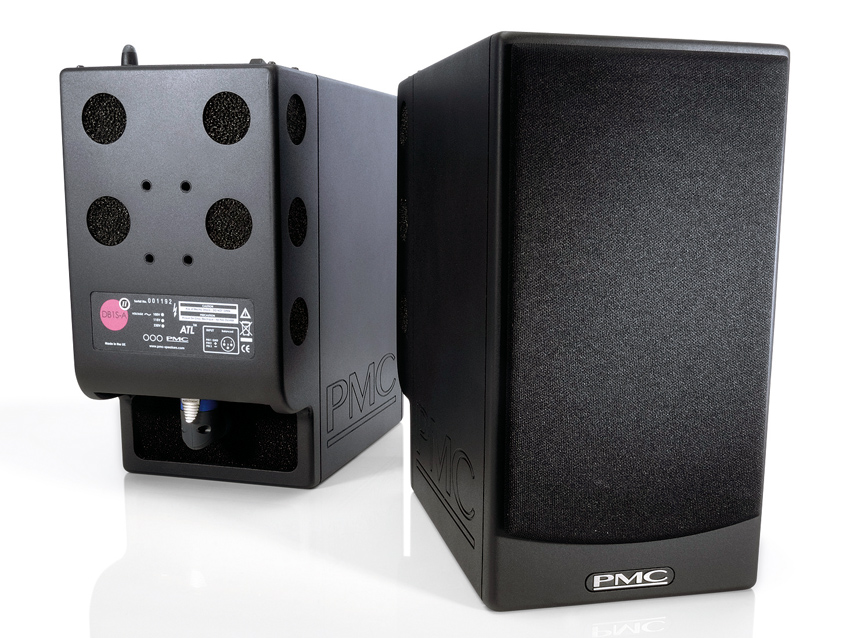MusicRadar Verdict
Outstanding tiny monitors that pack a serious punch. Accurately priced for their quality.
Pros
- +
Two-way transmission-line design. 140mm LF driver and 27mm soft-domed tweeter. 3 50Hz - 25kHz frequency response.
Cons
- -
You might want more controls.
MusicRadar's got your back
In the two decades since it was founded, PMC has cemented its position as one of the most innovative brands in loudspeaker design and manufacturing. Although the DB1S compact nearfield monitor has already been around for six or seven years, PMC continue to upgrade the design on a regular basis. This, the second generation of the active version, features a new and improved amplifier.
The obvious defining feature of the DB1 is its use of PMC's Advanced Transmission Line (ATL) design. Without wanting to go into too much technical detail, a transmission line speaker design places the driver at the end of a tube - the low-frequency sound waves produced at the back of the driver are emitted from this tube in phase with those produced by the front, boosting the sound pressure level around a tuned frequency range. If the transmission line length is correctly calculated to match the driver, the result is a loudspeaker with bass frequency response that belies the apparent limitations of the driver itself.
PMC clearly has faith in transmission line designs, and many others also believe that they offer superior bass extension with accurate transient response and cleaner, less hyped and muddied bass than more common bass reflex designs.
In use
Previous versions of the DB1S-A used Japanese Flying Mole amplifiers, neatly integrated into the back of the DB1's enclosure, but the key upgrade in the latest version is the new DS-001 class D amplifier module, designed specifically for the DB1S-A and its bigger brother, the TB1S-A. With a maximum output of 200W per speaker, the DS-001 can produce twice the power of the Flying Mole.
One convenient advantage of class D amplifiers' efficiency is that they generate very little heat, obviating the usual requirement for a heatsink and allowing the amplifier to fit into a more compact unit.
"After prolonged listening tests, both with finished mixes and works in progress, the DB1S-AII proved to be revealing and accurate without inducing fatigue."
It's worth noting that the DS-001 offers absolutely no adjustment other than a level control and power switch for each unit. Although this might seem unusual, we suspect there's logic behind it, placing the emphasis on adequate room treatment in order to achieve an even frequency response.
Although we didn't have a pair of the original DB1S-A model to make a direct comparison with, the new amplifiers certainly deliver in terms of accurate sound reproduction. After prolonged listening tests, both with finished mixes and works in progress, the DB1S-AII proved to be revealing and accurate without inducing fatigue.
If you closed your eyes you'd believe you were listening to much larger monitors, with low frequency notes and kick drums being reproduced with accuracy and punch.
The design of the DB1S takes advantage of the benefits of small speaker drivers, offering lightning-fast transients and precise recreation of dynamic music, while still delivering very acceptable response right down into the lower registers
Summary
Our overall impression is that the DB1S-AII is highly musical. Although these speakers are clean, flat and neutral, they produce an engaging sound and punch way above their weight. We have no doubt that they'd be incredible in a home studio, but we suspect the price will put the vast majority of potential home users off and they're more likely to find their home in smaller professional studios.
If you're looking for high-end monitoring but space is at a premium, check the DB1S-AIIs out.
Future Music is the number one magazine for today's producers. Packed with technique and technology we'll help you make great new music. All-access artist interviews, in-depth gear reviews, essential production tutorials and much more. Every marvellous monthly edition features reliable reviews of the latest and greatest hardware and software technology and techniques, unparalleled advice, in-depth interviews, sensational free samples and so much more to improve the experience and outcome of your music-making.
“An incredible experience that went beyond just teaching music”: The UK’s biggest free music making weekend is extended to four days
“This time it’s all about creativity… Go crazy. Do whatever you wanna do with it”: Budding luthiers, assemble! Harley Benton’s DIY Kit Challenge is now open and there are prizes to be won
"At first the tension was unbelievable. Johnny was really cold, Dee Dee was OK but Joey was a sweetheart": The story of the Ramones' recording of Baby I Love You











